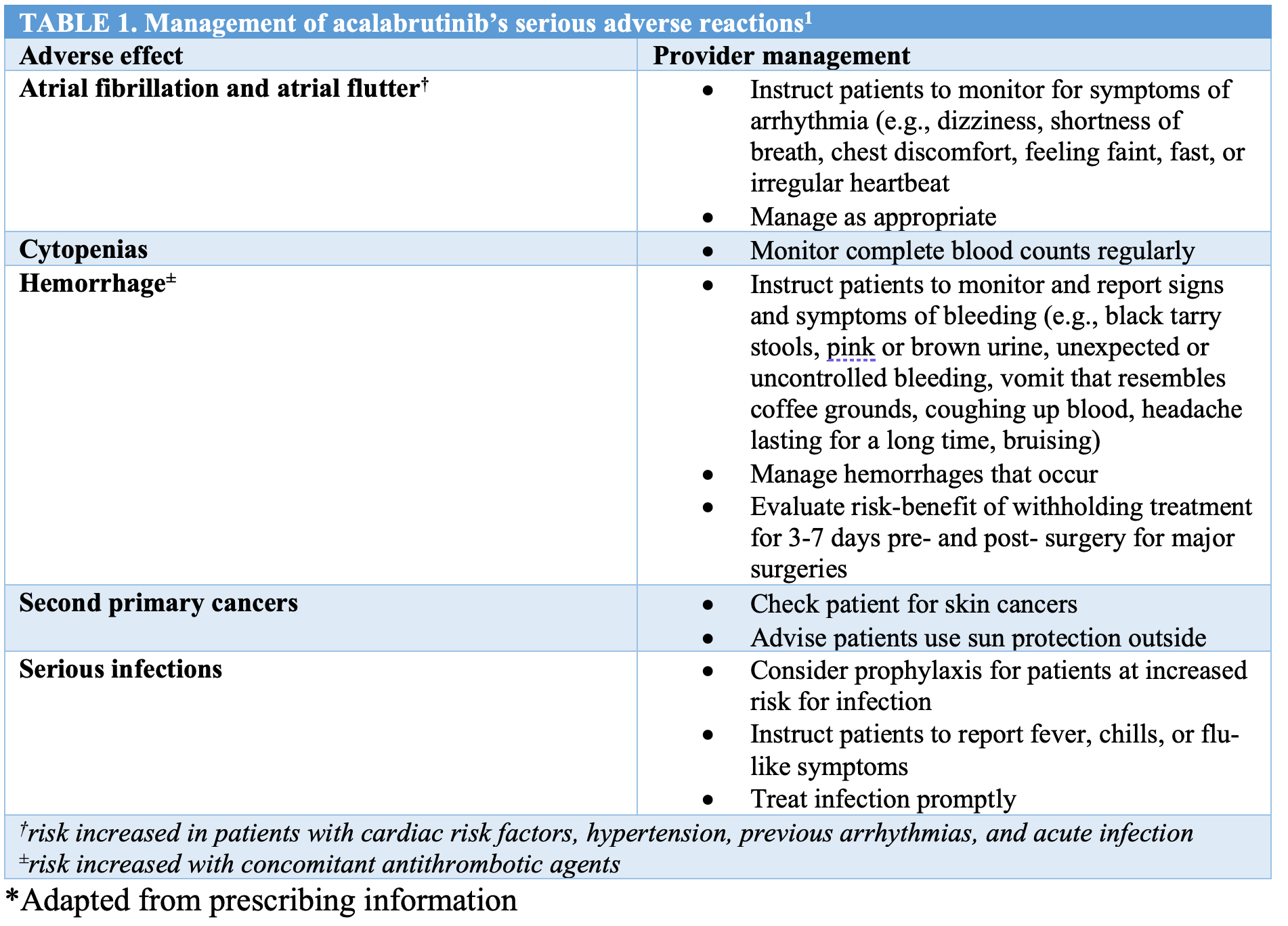Article
Oncology Overview: Acalabrutinib (Calquence) for Chronic Lymphocytic Leukemia
Author(s):
Acalabrutinib (Calquence; AstraZeneca) provides efficacy while maintaining favorable tolerability for patients with chronic lymphocytic leukemia.
Acalabrutinib (Calquence; AstraZeneca Pharmaceuticals LP) is a targeted therapy to delay or prevent the growth of cancer cells in chronic lymphocytic leukemia (CLL) or small lymphocytic lymphoma (SLL).1 It is also a treatment option for patients with mantle cell lymphoma (MLL) who have received at least 1 prior therapy.1
The American Cancer Society estimates more than 60,000 new cases of leukemia in the United States are diagnosed annually.2 CLL is among the more common types of leukemia in adults and accounts for more than 20,000 new cases annually.2,3
In CLL, bone marrow creates too many abnormal lymphocytes (B cells) that have difficulty fighting infection.3,4 CLL occurs around middle age and patients may notice swollen lymph nodes and feeling weak or tired.4 Patients with CLL, often facing multiple comorbidities, may require ongoing treatment for many years, therefore, treatment tolerability is highly valued.3
Indications and Dose
Acalabrutinib’s recommended dose is 100 mg orally every 12 hours until disease progression or unacceptable toxicity.1 Patients who miss a dose by more than 3 hours should skip the missed dose and take the next dose at the regularly scheduled time.1
Adult patients with MCL, CLL, or SLL take acalabrutinib as monotherapy. Patients with previously treated CLL or SLL take acalabrutinib as combination therapy with obintuzmab. Acalabrutinib administration starts at cycle 1 and obintuzmab starts at cycle 2 for a total of 6 cycles (each cycle is 28 days). Patients take acalabrutinib prior to obintuzmab when given on the same day.1
Physicians should avoid prescribing acalabrutinib to patients with severe hepatic impairment.1 Researchers have not evaluated acalabrutinib in patients with severe renal impairment (eGFR < 29 mL/min/1.73m2) or dialysis.1
Mechanism of Action
Acalabrutinib works by blocking a protein called Bruton tyrosine kinase (BTK).1,5 BTK inhibition in B cells helps to prevent growth and survival signals, causing B cells to die.5
FDA Approval
Acalabrutinib’s approval was among the first granted under Project Orbis.3 Project Orbis is an FDA Oncology Center of Excellence initiative to provide concurrent submission and review of oncology medications among international partners.6 This collaboration allows patients with cancer to receive earlier access to products in other countries where significant delays in regulatory submissions may occur.6
Acalabrutinib approval was based on positive results from a pair of phase 3 clinical trials: ELEVATE-TN and ASCEND. Both trials showed improvement in progression-free survival and tolerability.3
ELEVATE-TN evaluated patients with previously untreated CLL. The trial compared combination acalabrutinib with obintuzumab or acalabrutinib monotherapy versus a standard-of-care combination (chlorambucil plus obintuzumab).
ASCEND evaluated therapy for patients with relapsed or refractory CLL.1 This trial compared acalabrutinib monotherapy versus investigator’s choice of either rituximab in combination with idelalisib, or rituximab in combination with bendamustine.3
Adverse Effects (AEs)
The most common AEs are headache, diarrhea, musculoskeletal pain, upper respiratory tract infection, and bruising.1
Providers should refer to the package insert for recommended dose modifications and management in the event of an adverse reaction (see Table 1).1

Drug Interactions
CYP3A inhibitors (e.g., itraconazole, erythromycin, fluconazole, diltiazem) may increase acalabrutinib toxicity, whereas inducers (e.g., rifampin) may reduce acalabrutinib activity.1 Avoid acalabrutinib co-administration with strong CYP3A inhibitors and inducers.
Prescribers should consider reducing acalabrutinib’s dose to 100 mg once daily for use with moderate CYP3A inhibitors. Providers can increase acalabrutinib’s dose to 200 mg every 12 hours if using strong CYP3A inducers cannot be avoided.1
Patients should take H2-receptor antagonists 2 hours after acalabrutinib. Patients should also separate antacid administration by at least 2 hours. Avoid co-administration with proton pump inhibitors.1
Pregnancy and Lactation
Acalabrutinib can cause fetal harm based on findings in animals. Females of reproductive potential should take a pregnancy test prior to therapy and use effective contraception during treatment.
Patients should continue contraception use for at least 1 week after the last dose of acalabrutinib.1 Acalabrutinib has the potential to cause adverse reactions in a breastfed child. Lactating women should not breastfeed while taking acalabrutinib and for at least 2 weeks following the last dose.1
About the Author
Ashley Walsh, PharmD, is a pharmacist at Mohegan Pharmacy in Uncasville, CT.
References
1. Calquence. Prescribing information. AstraZeneca Pharmaceuticals LP; 2019. Accessed December 29, 2021. https://www.azpicentral.com/calquence/calquence.pdf
2. Key statistics for chronic lymphocytic leukemia. American Cancer Society. Updated January 12, 2021. Accessed December 29, 2021. https://www.cancer.org/cancer/chronic-lymphocytic-leukemia/about/key-statistics.html
3. Calquence approved in the US for adult patients with chronic lymphocytic leukemia [News release]. AstraZeneca Pharmaceuticals LP. November 21, 2019. Accessed December 29, 2021. https://www.astrazeneca.com/media-centre/press-releases/2019/calquence-approved-in-the-us-for-adult-patients-with-chronic-lymphocytic-leukaemia-21112019.html#
4. Chronic lymphocytic leukemia treatment (PDQ®)–patient version. National Cancer Institute. Updated September 20, 2021. Accessed December 29, 2021. https://www.cancer.gov/types/leukemia/patient/cll-treatment-pdq
5. Taking Calquence. AstraZeneca Pharmaceuticals LP. Updated August 2021. Accessed January 2, 2022. https://www.calquence.com/cll/how-to-take-calquence.html#taking-how
6. Project Orbis. U.S. Food and Drug Administration. Updated September 17, 2019. Accessed January 2, 2022. https://www.fda.gov/about-fda/oncology-center-excellence/project-orbis






